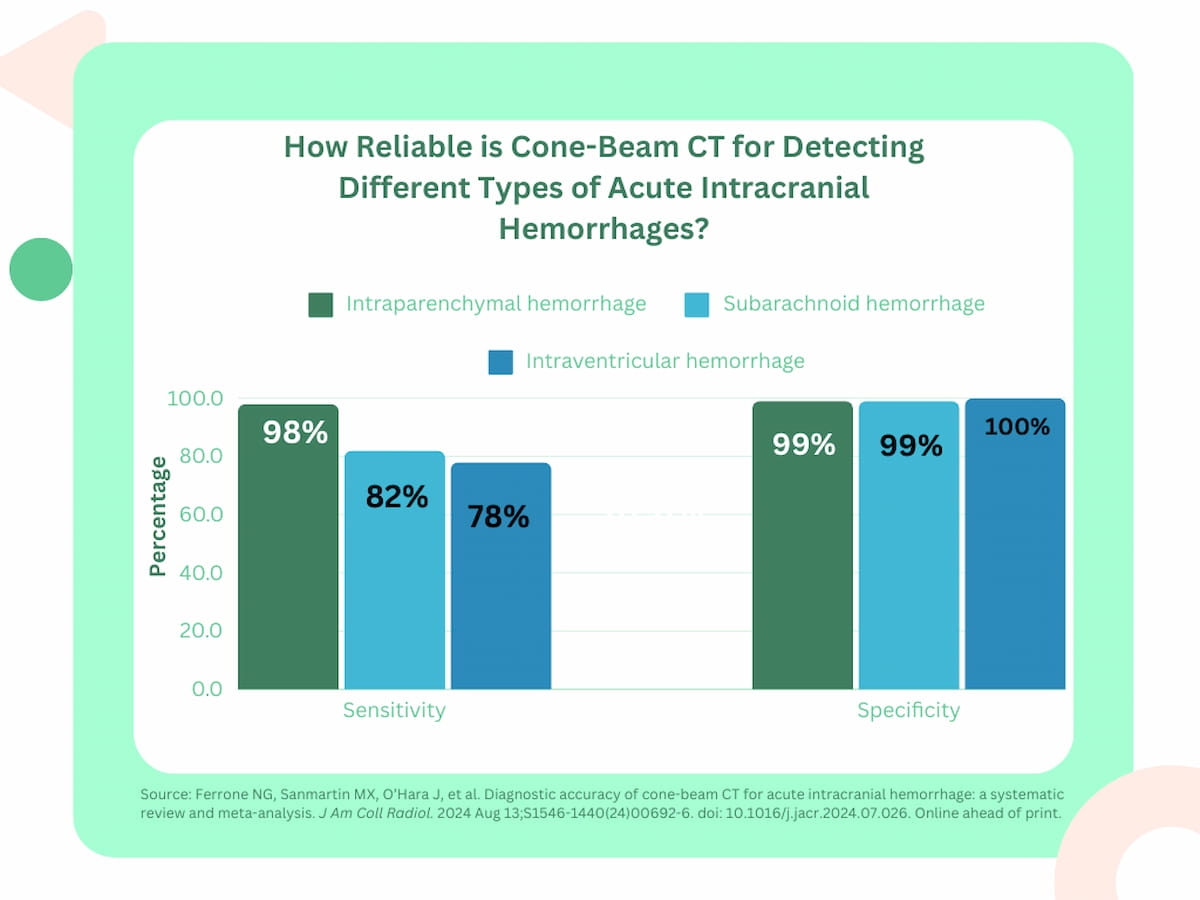How reliable is cone-beam computed tomography (CBCT) for the detection of acute intracranial hemorrhages (ICHs)?
In a new meta-analysis, recently published in the Journal of the American College of Radiology, researchers reviewed seven studies that involved a total of 466 patients with suspected stroke. In addition to examining the effectiveness of CBCT for ICH diagnosis, the meta-analysis authors evaluated the impact of CBCT for detecting different types of ICH, including intraparenchymal hemorrhage (IPH), subarachnoid hemorrhage (SAH) and intraventricular hemorrhage (IVH).
The researchers noted a high pooled specificity rate of CBCT for ICH (99 percent) as well as the different types of ICH with 99 percent specificity for SAH and IPH, and 100 percent specificity for IVH. However, the meta-analysis authors noted variable sensitivity rates. While CBCT demonstrated a pooled sensitivity rate of 98 percent for IPH, the researchers pointed out 82 percent and 78 percent sensitivity rates for SAH and IVH respectively.
“The higher false-negative rates for CBCT for detection of SAH and IVH, compared to IPH, resulted in the overall lower pooled sensitivity for ICH. These findings indicate that CBCT could potentially lead to missed diagnosis of ICH and possibly erroneous treatment decisions in acute ischemic stroke patients,” wrote lead study author Nicholas G. Ferrone, M.D., who is affiliated with Northwell Health in New Hyde Park, N.Y., and the Institute of Health System Science at the Feinstein Institutes for Medical Research in Manhasset, N.Y., and colleagues.
While noting that IPH, particularly in the presence of a large vessel occlusion (LVO), is the prevailing diagnosis to rule out prior to a mechanical thrombectomy, the meta-analysis authors emphasized that reduced sensitivity of CBCT for SAH and IVH is a significant concern when it comes to determining whether patients are viable candidates for intravenous thrombolysis.
“A multimodal approach, including CBCT-angiography and CBCT-perfusion to confirm LVO and perfusion deficit, respectively, may improve confidence in treatment decision-making,” suggested Ferrone and colleagues. “However, it must be noted that the latter imaging technique is only available on the newest generation of angiography equipment.”
Three Key Takeaways
1. High specificity, variable sensitivity. CBCT shows high specificity for detecting intracranial hemorrhages (ICH) with 99 percent specificity for SAH and IPH, and 100 percent for IVH. However, the sensitivity varies, with lower sensitivity for SAH (82 percent) and IVH (78 percent) compared to IPH (98 percent).
2. Diagnostic limitations. Due to the lower sensitivity for detecting SAH and IVH, CBCT may miss certain types of hemorrhages, potentially leading to incorrect treatment decisions in acute ischemic stroke patients.
3. Technological improvements. Recent advancements in CBCT technology have improved imaging quality, reducing the rate of insufficient imaging. The authors noted that refinement of CBCT has focused on differentiating ICH from contrast extravasation after mechanical thrombectomy.
While the meta-analysis authors found that image quality, overall, was deemed insufficient for up to 9.4 percent of CBCT exams, they noted that technological advances with CBCT may have contributed to a lower rate of insufficient imaging quality (up to 1 percent) reported in CBCT studies published since 2016.
“Further refinement has focused on assessing the ability of CBCT for discriminating between ICH and contrast extravasation following mechanical thrombectomy to broaden the utilization of CBCT in the stroke workflow,” added Ferrone and colleagues.
(Editor’s note: For related content, see “FDA Clears AI Advance for Detecting Intracranial Hemorrhage on Non-Contrast CT,” “Study Shows Significant Overutilization of Head and Neck CT Angiography in the ER” and “Head CT for Acute Stroke Patients: Study Shows 22 Percent Improvement for 30-Minute Turnaround Times.”)
In regard to study limitations, the authors acknowledged significant heterogeneity in the reviewed studies with respect to data variables and statistical analysis. Small sample sizes in some of the studies prevented reliable estimates of positive and negative predictive values for ICH detection, according to the researchers.
